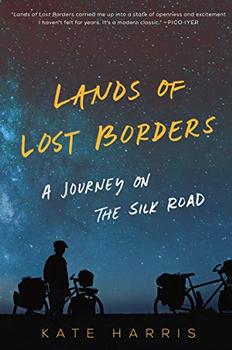Summary | Excerpt | Reviews | Beyond the Book | Readalikes | Genres & Themes | Author Bio

Critics' Opinion:
Readers' Opinion:
First Published:
Aug 2018, 320 pages
Paperback:
Jun 2019, 320 pages
 Book Reviewed by:
Book Reviewed by:
Karen Lewis
Buy This Book
Excerpt
Lands of Lost Borders
Long before space flight, a pair of avid cyclists recognized the importance of the angle at which a wing meets the wind. Wilbur preferred long, languid rides on country roads while Orville loved racing, the faster the better. Th is blend of endurance and enthusiasm, and steadfastness and speed, enabled the Wright brothers from Ohio to soar where others had crashed, often fatally, including Otto Lilienthal. The doomed "father of gliding" permanently fell from the sky in 1896, but Orville and Wilbur took inspiration from his achievements and decided to fashion their own flying machines using tools and parts from the bicycle repair shop they ran in Dayton. To make the wings they used unbleached "Pride of the West" muslin, a tight-woven cotton cloth ("fine as linen, soft as silk!") more commonly deployed in women's undergarments. For the ribs of the wings they used lightweight ash wood, and for the frame, lumber from a giant spruce. They tested the angles of incidence (also known as "angles of attack") of different wing shapes inside a homemade wind tunnel, and over years of trial and error realized—their eureka insight—that by warping wing tips in opposite directions, they could create different amounts of lift on each, making the plane tilt and turn. Previous glider designs forced pilots to steer by throwing around their body weight, meaning control was fickle. By belting the wing tips to their waist via wires and a harness, the Wright brothers could maneuver their Flyer by sashaying from side to side, the way you steer a bicycle at high speed less with handlebars than your hips.
For a launch pad the Wright brothers chose Kitty Hawk, a small town not far from where Mel and I finished our cross-country traverse on North Carolina's Outer Banks, where the soft landing of sand dunes and reliable winds offer ideal conditions for flight. Orville won the coin toss that decided which brother would attempt the first sustained, powered, heavier-than-air f light that cold December morning in 1903, when the wind blew in the Wrights' favor, which is to say strongly against them. Although Orville didn't fly far that morning—a hundred and twenty feet, or half the length of a modern Boeing 747 jet—the glory was in the details: a machine took off under human control, soared for twelve seconds under its own power, and landed as high as it launched, meaning it hadn't simply glided downhill. First flight.
That same day Wilbur bested his brother's pioneering flight by lasting nearly a minute in the air and travelling 852 feet, roughly the length of the Marco Polo Bridge in Beijing. Seven years after that, the world's first commercial cargo flight carried two bolts of silk from Dayton to Columbus, Ohio. And in 1969, roughly half a century later, Neil Armstrong brought fabric from the wing and wood from the propeller of the original Wright Flyer to the moon and back. I've always thought the moonwalker's pithy first words— "That's one small step for man, one giant leap for mankind"— more accurately described the Wrights' accomplishment. After all, Orville and Wilbur figured out how to fly from scratch, without institutional support of any kind, without a Mission Control monitoring their every move. I especially loved the fact that the brothers' success in flight had depended on a bicycle. The Wright Flyer, a homespun contraption of cloth and wood and wire, relied on a modified sprocket chain to power its twin propellers, and the hub of a bicycle wheel to launch off a railing and into history.
My own bike nearly launched off the road in Georgia, but only because the puddles turned to ice the higher we climbed. "Wish we had our riding boots!" Mel called out, a grin in her voice, and I was relieved she was in a good mood despite the dropping temperature. The two of us used to wear our scuffed leather riding boots to elementary school in the winter, not because the thin cowhide kept our toes warm, or because they were stylish by the already ruthless standards of the sixth grade, but because we'd discovered their treadless soles were essentially ice skates without blades. We'd taken turns towing each other across the frozen schoolyard at recess, seeing who could catch the biggest air on launch ramps built from snow. These were small acts of exposure, tiny flights into risk, and yet the world seemed a little larger each time we landed. Mostly we crashed unglamorously into snowbanks, then dug ourselves out to do it all over again.
Excerpted from Lands of Lost Borders by Kate Harris. Copyright © 2018 by Kate Harris. Excerpted by permission of Dey Street Books. All rights reserved. No part of this excerpt may be reproduced or reprinted without permission in writing from the publisher.





The House on Biscayne Bay
by Chanel Cleeton
As death stalks a gothic mansion in Miami, the lives of two women intertwine as the past and present collide.

The Flower Sisters
by Michelle Collins Anderson
From the new Fannie Flagg of the Ozarks, a richly-woven story of family, forgiveness, and reinvention.

The Funeral Cryer by Wenyan Lu
Debut novelist Wenyan Lu brings us this witty yet profound story about one woman's midlife reawakening in contemporary rural China.
Your guide toexceptional books
BookBrowse seeks out and recommends the best in contemporary fiction and nonfiction—books that not only engage and entertain but also deepen our understanding of ourselves and the world around us.